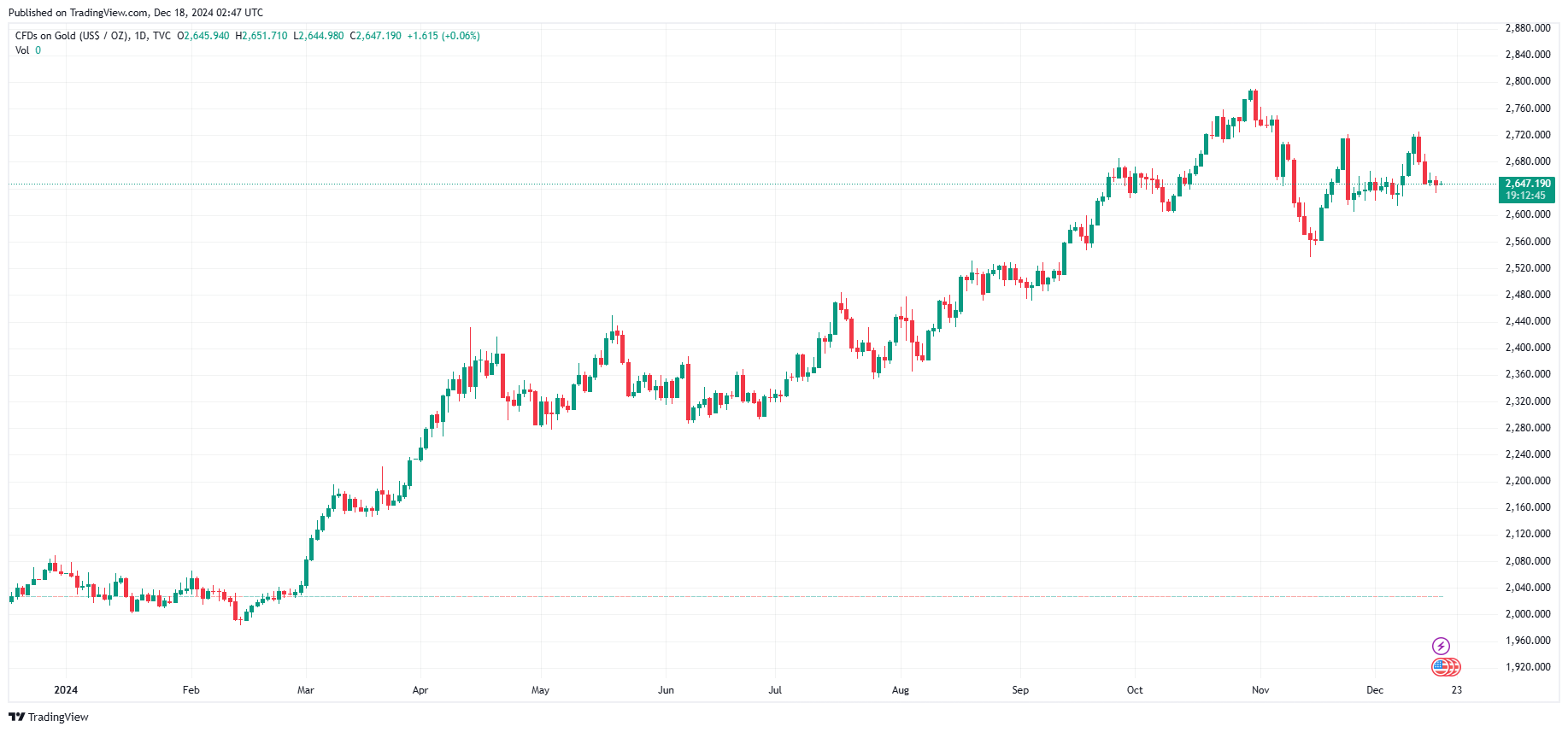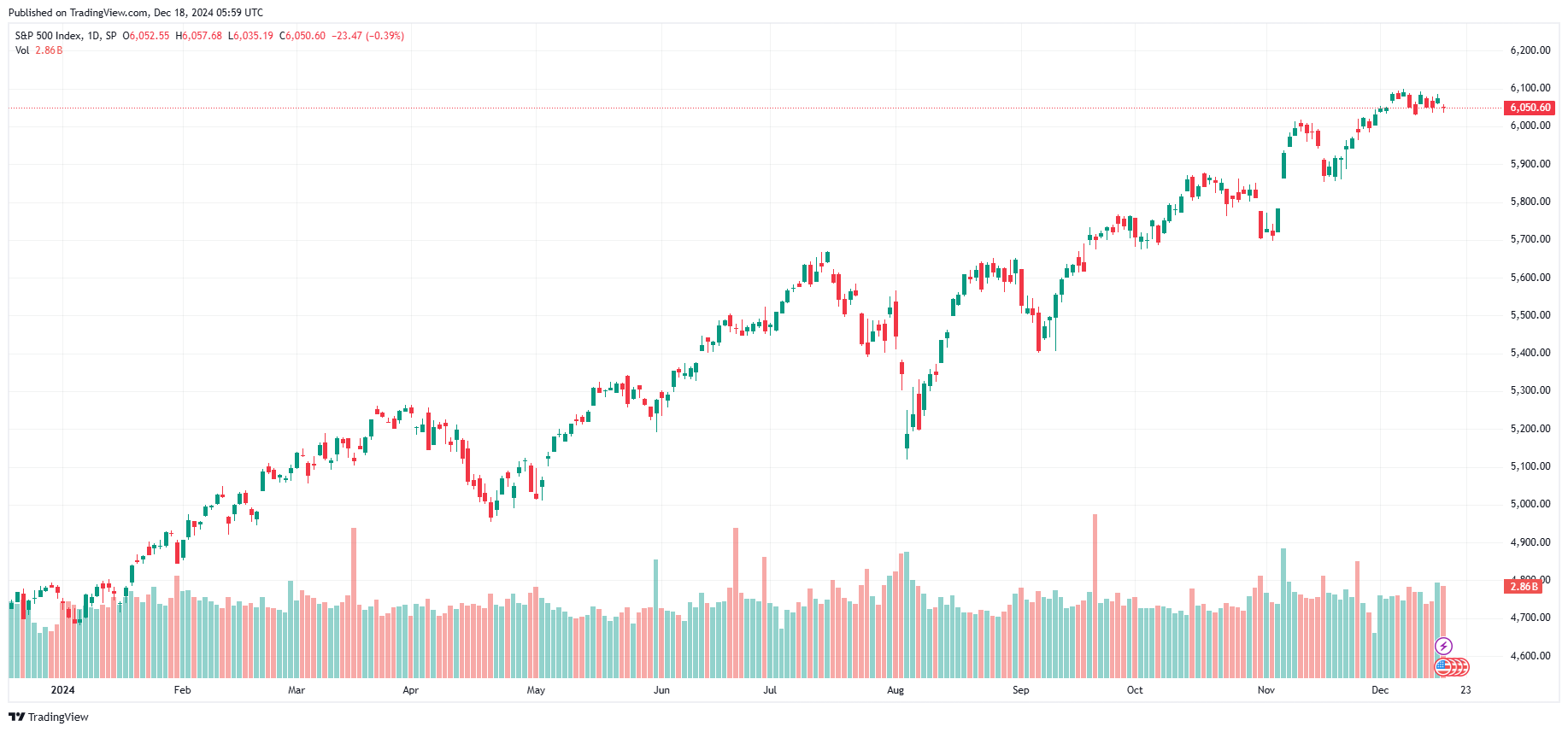With the price of both gold and stocks rising in recent months, the debate between trading gold or stocks remains a hot topic among investors.
In this article, we will be taking a deep dive into the performance of the gold and stock markets to discuss the features and merits of both investment assets in 2025.
Key Points
- In 2024, both gold and stocks have shown strong performance, with gold continuing its upward trend due to economic uncertainties, and the S&P 500 reaching new highs driven by technological advancements and positive corporate earnings.
- Gold offers stability and acts as a hedge against inflation, making it a less risky option for preserving wealth. Stocks, though more volatile, provide higher potential returns and dividends, making them suitable for long-term wealth building.
- Combining gold and stocks in your investment portfolio can balance stability and growth potential, allowing you to manage risks effectively and pursue diverse financial goals in a dynamic market environment.
In recent years, gold has once again demonstrated its resilience, reasserting its claim as a safe haven asset. During the economic turmoil of the COVID-19 pandemic, gold prices peaked at an all-time-high of $2,089 per ounce in August 2020 [1].
Even in the face of rising interest rates and inflation concerns, gold has managed to hold its ground, trading at an average of US$1,940.54 per ounce in 2023 – 8% higher than 2022 [2]. The asset has since achieved new record highs; as of December 2024, the price of gold is $2,650 per ounce [3].
Meanwhile, stocks have been on a rollercoaster ride. The rapid recovery of the stock market post-2020 crash, fuelled by unprecedented monetary policies and fiscal stimulus, has been nothing short of remarkable.
The S&P 500, for instance, has climbed over 80% since the beginning of 2020 [4]. Tech giants like Apple, Amazon, and Tesla have led this charge, with their stocks soaring in the same period.
Yet, this bull market is not without its volatility.
In 2022, fears of rising inflation and geopolitical tensions triggered sharp corrections, highlighting the inherent risks in stock trading [5].
Following this, 2023 saw steadier growth, with the S&P 500 closing the year with a gain of 26.29% [6]. This momentum continued in 2024, with the index posting its best first nine months of the year in an election year since 1950, driven by a strong U.S. economic backdrop, moderating inflation pressures, and investor enthusiasm around artificial intelligence (AI). By the end of December 2024, the S&P 500 had gained approximately 15% for the year [7].
In the year 2025, will the glitter of gold continue to shine, or will the growth potential of stocks dominate?
Understanding the recent performance and trends of these assets can provide valuable insights for making informed trading decisions.
Gold Price Trend [8,9,10,11]

Gold’s journey through 2024 has been marked by a steady climb, with prices pushing towards new record highs.
Historically, gold closed the 2023 year at $2,062.92 per ounce, marking a gain of 13.08% from the previous year.
The upward trajectory has continued into 2024, with gold trading above $2,250 per ounce as of April, nearing the all-time high reached in December of the previous year.
The recent rate cuts by the Federal Reserve have further fuelled the rise in gold prices. As of December 2024, the Fed has implemented three consecutive rate cuts, bringing the benchmark rate down to a range of 4.25% to 4.5%.
This has brought gold prices rocketing to $2,650 per ounce, reflecting a remarkable 28.66% increase since the start of the year. The current average daily trading volume for gold is approximately $150 billion, highlighting its liquidity and appeal as a safe-haven asset.
Analysts predict that gold prices could exceed $3,000 per ounce in 2025, driven by factors such as lower interest rates and increased central bank purchases.
Stock Price Trend [12,13,14]

To compare the performance of gold against stocks, let’s take a closer look at the S&P 500. The S&P 500 serves as a barometer for the broader U.S. stock market and is often used as a proxy for the health of the economy.
In 2024, the index continued to reach new heights, closing above 5,000 for the first time in history. This milestone was achieved on the back of a strong start to the year, defying many analysts’ expectations who had anticipated economic concerns to dampen market performance.
The index has seen a year-to-date increase of 28.55% as of December 2024, with the index closing at 4,935.72 points.
This was driven by better-than-expected corporate earnings. About 78% of S&P 500 companies that reported first-quarter earnings announced positive earnings-per-share surprises.
Buoyed by positive corporate earnings, investor confidence, and favourable economic indicators, the S&P 500 has charted a bullish trend throughout 2024.
Difference between Gold and Stocks
When it comes to investing, gold and stocks represent two fundamentally different asset classes, each with its own set of characteristics and investment profiles.
While they are both on the uptrend, there are essential differences between gold and stocks investors should take note of.
Potential Returns
Gold
Gold’s price is influenced by a variety of factors, including currency values, interest rates, and geopolitical events. While it doesn’t generate cash flow, it can provide significant returns during periods of high inflation or economic instability. For instance, between the financial crisis of 2008 and 2012, gold prices increased by over 10% [15].
Stocks
Stocks represent ownership in a company and their returns come from both price appreciation and dividends. The average annual return for the S&P 500, which is a good proxy for the US stock market, has been about 10% before inflation over the last century [16]. However, this includes periods of significant downturns and recoveries.
Risk level for each asset
Gold
Due to its unique status both as a rare commodity and universal acceptance as an exchange of value, gold carries lower risk compared to stocks. During times of severe uncertainty, there is a historical tendency for gold to rise in popularity as investors seek safety. However, it’s not entirely risk-free; gold prices can be volatile in the short term and are also affected by mining supply and demand.
Stocks
Stocks are considered a higher-risk investment. They can be affected by market sentiment, economic cycles, and company-specific news. Stocks are also driven by important discoveries, as evidenced by the dot.com bubble and the latest hype around AI. Thus, the volatility of stocks can lead to higher losses, but also potentially higher gains compared to gold.
Period of investment
Gold
Gold is often viewed as a long-term investment. It doesn’t expire or become obsolete, and many investors hold gold for years or even decades as part of their portfolio.
Stocks
The optimal holding period for stocks varies. While some traders engage in short-term trading, the most successful stock investors, like Warren Buffett, advocate for a long-term approach, holding undervalued stocks for several years or more to realise substantial gains.
Dividend earning
Gold
Gold itself does not produce any income. It does not pay dividends or interest. The only financial gain investors can realise from gold is through price appreciation at the point of selling their holdings.
Stocks
Many stocks, especially those of well-established companies, pay regular dividends. These can provide a steady income stream and can be reinvested to purchase more shares, compounding the investment’s growth over time.
Gold or Stocks: Which to Trade?
The investment landscape of 2025 presents a compelling case for both gold and stocks, each with its unique advantages and considerations. The decision on which to trade can be informed by the differences in performance, risk, and potential returns that we’ve discussed.
Gold has demonstrated a strong price trend, particularly as a hedge against inflation and economic uncertainty. Its role as a safe haven makes it an attractive option for those looking to preserve capital and maintain purchasing power.
Stocks, represented by the performance of the S&P 500, offer the allure of higher potential returns and dividends. The stock market’s resilience and growth potential make it suitable for those seeking to build wealth over the long term.
So, should you trade gold or stocks? The answer is: Why not both? Diversifying your portfolio with a mix of gold and stocks can provide a balanced approach, leveraging the stability of gold and the growth potential of stocks.
Whether you’re inclined towards the enduring value of gold or the dynamic opportunities in the stock market, Vantage offers a platform to trade both through CFDs.
Open a live account with Vantage today and take advantage of the diverse investment opportunities available in 2025. Diversify your portfolio, manage your risks, and trade gold or stock CFDs with confidence.
Conclusion
In conclusion, the debate between gold and stocks is not about which asset is superior, but rather about how each can play a distinct role in a well-rounded investment strategy.
Gold, with its steady allure, offers security and acts as a hedge against inflation, making it a valuable component for those seeking stability in their portfolio.
Stocks, on the other hand, bring the promise of growth and the potential for dividends, appealing to those with a longer time horizon and a higher risk appetite.
As we navigate through 2025, the economic landscape continues to evolve, and with it, the strategies for trading and investment. By understanding the inherent qualities and historical performance of both gold and stocks, investors can make informed decisions that align with their financial goals and risk tolerance.
Sign up for a Vantage live trading account today and get started to trade both gold and stocks CFDs by speculating their price changes without having to own the underlying product.
References
- “Has Gold Been a Good Investment Over the Long Term? – Investopedia”. https://www.investopedia.com/ask/answers/020915/has-gold-been-good-investment-over-long-term.asp . Accessed 7 June 2024.
- “Gold Demand Trends Full Year 2023 – World Gold Council”. https://www.gold.org/goldhub/research/gold-demand-trends/gold-demand-trends-full-year-2023 . Accessed 29 August 2024.
- “How Much Is an Ounce of Gold Worth? – Money”. https://money.com/how-much-is-an-ounce-of-gold-worth/ . Accessed 18 December 2024.
- “Stock market returns since 2020 – S&P 500 Data”. https://www.officialdata.org/us/stocks/s-p-500/2020 . Accessed 29 August 2024.
- “Stocks rebound after Dow, S&P 500 and Nasdaq all enter “correction” territory – CBS News”. https://www.cbsnews.com/news/stock-market-rebound-s-p-500-dow-nasdaq-correction-inflation-2022-01-24/ . Accessed 7 June 2024.
- “S&P 500 Total Returns – Slickcharts” . https://www.slickcharts.com/sp500/returns . Accessed 18 December 2024.
- “2024 stock market reflections – Ameriprise Financial”. https://www.ameriprise.com/financial-news-research/insights/2024-stock-market-reflections . Accessed 18 December 2024.
- “Gold price forecast for spring 2024: Here’s what experts predict – CBS News”. https://www.cbsnews.com/news/gold-price-forecast-for-spring-2024-heres-what-experts-predict/ . Accessed 7 June 2024.
- “Gold Prices – 100 Year Historical Chart – Macrotrends”. https://www.macrotrends.net/1333/historical-gold-prices-100-year-chart . Accessed 7 June 2024.
- “Gold – Trading Economics”. https://tradingeconomics.com/commodity/gold . Accessed 18 December 2024.
- “GOLD PRICE FORECAST 2024, 2025, 2026 AND 2027 – The Economy Forecast Agency” https://longforecast.com/gold-price-today-forecast-2017-2018-2019-2020-2021-ounce-gram . Accessed 18 December 2024.
- “Past performance suggests S&P 500 has further to go after record high – Financial Times”. https://www.ft.com/content/6810f509-feaf-4f4f-ab96-5784b94fa8f8 . Accessed 7 June 2024.
- “S&P 500 Total Returns – Slickcharts” . https://www.slickcharts.com/sp500/returns . Accessed 18 December 2024.
- “Wall Street revamps 2024 S&P 500 targets after record-setting stock-market rally – MorningStar”. https://www.morningstar.com/news/marketwatch/20240325111/wall-street-revamps-2024-sp-500-targets-after-record-setting-stock-market-rally . Accessed 7 June 2024.
- ” Gold prices during and after the Great Recession – Beyond the Numbers”. https://www.bls.gov/opub/btn/volume-2/pdf/gold-prices-during-and-after-the-great-recession.pdf . Accessed 7 June 2024.
- “Historical Average Stock Market Returns for S&P 500 (5-year to 150-year averages) – Trade That Swing”. https://tradethatswing.com/average-historical-stock-market-returns-for-sp-500-5-year-up-to-150-year-averages/ . Accessed 7 June 2024.




